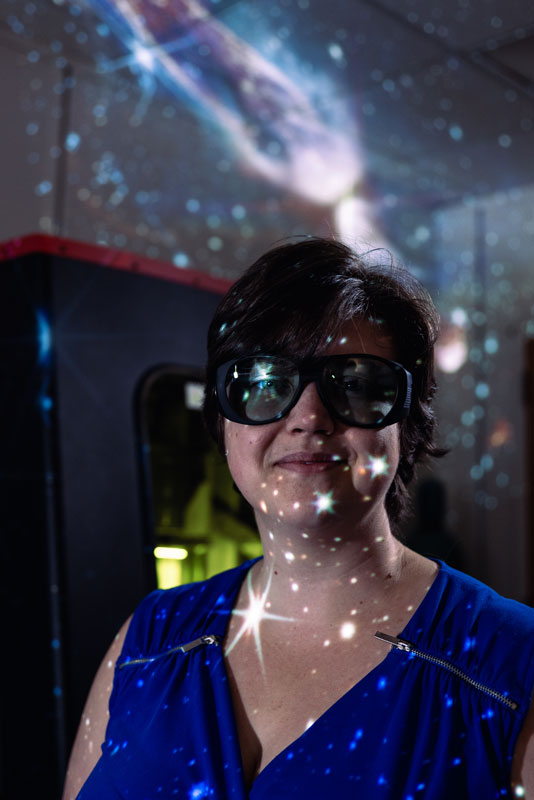It was 1969, and space was simple. Only a handful of countries had managed to launch satellites into orbit. Just two, the Soviet Union and the United States, were vying for supremacy. And the lunar surface belonged to America alone.
Half a century later, dozens of countries and private companies have since jammed space full of tens of thousands of manmade objects. And humanity’s ambitions for space engineering are only growing: manned missions to Mars, permanent lunar bases, and ever-larger telescopes to peer into the cosmos.
To fulfill those ambitions, the University of Florida has launched the Space Mission Institute, an interdisciplinary hub for space research. The institute helps bring together researchers like Tori Miller, Ph.D., and Christopher Petersen, Ph.D., both in the Herbert Wertheim College of Engineering, who are partnering to imagine the future of space exploration, where self-guided satellites repair and upgrade one another and where we can build structures in space far too big to launch from Earth.
Like the current space age, there’s nothing simple about these goals. But space exploration has always inspired us to meet our greatest challenges.

Tori Miller, Ph.D.
Permanent bases or next-generation space stations will gobble up power. That’s why the U.S. defense research agency DARPA – which funds Miller’s research – aims to craft solar arrays 100 meters in diameter. Such an array would be several times the size of the solar panels currently used by the International Space Station, which are the largest ones in space.
A device that size can’t be made on Earth and launched; it must be built in orbit.
“There hasn’t been any demonstration of this scale of manufacturing in space,” said Miller, who came to space research when DARPA called for expertise in materials science, her specialty.
Her plan for fabrication relies on laser bending, which uses high-powered light sources to turn sheet metal into three-dimensional objects without ever touching the surface. Think of it as spacefaring, metallic origami.
With the right bends and twists, Miller hopes to develop small, repeatable units that can be assembled into a large, sturdy truss capable of supporting massive blankets of solar panels. The same assembly line-like process could in theory build other structures as well. But space engineering demands a level of reliability that laser forming processes can’t yet satisfy.
“Laser bending isn’t very repeatable right now,” Miller said. So, her research group is analyzing the myriad conditions that affect the final shape, everything from temperature to material thickness to even minor surface contamination. And the final product has to withstand the demands of space. “We need to make sure the material is as strong and as reliable coming out of the laser bending process as it was going in.”
When the kinks are worked out and the origami-like plans for production are drawn up, Miller will need a hand putting the structure together hundreds of miles above Earth’s surface.
In the neighboring building, Petersen is testing autonomy for robotic arms mounted on satellite buses – just the kind that may one day build Miller’s solar panels.
Petersen came to UF in 2022 after working with the U.S. Air Force and Space Force on autonomous satellite systems. Developing these programs is crucial for the kind of space engineering that Miller is pursuing. “We want to implement autonomy on board satellites so that Tori’s processes can be performed safely with minimal human interaction, as space is a domain that is congested with limited constant communication,” Petersen said.
Similar automation is key for creating satellites that can safely draw near and interact with other satellites to refuel them, replace damaged components, or upgrade their electronics. More than 40% of satellites face some kind of failure during their first year of operation, and the rate only increases over time. In orbit repairs and upgrades completed by other satellites would extend the life and capability of these expensive and vital machines in a way that isn’t possible with human mechanics.
But while programmers on land have access to terabytes of storage and gigabytes of memory, satellites are still in the megabyte era. That discrepancy comes from the unique demands of space, especially the need to shield electronics from crippling radiation. These restrictions put space computing 10 years behind terrestrial computing, Petersen said.
To compensate, Petersen researches lightweight, computationally aware algorithms that accomplish mission goals with minimal resources. Some missions need satellites to act every couple seconds; other satellites may only need to act every few hours. “Our algorithms adjust computation by themselves to meet these constraints,” Petersen said.
These are the kinds of collaborations the Space Mission Institute is designed to foster. Formed in early 2024 with $2.5 million from UF President Ben Sasse’s strategic funding initiative, the institute serves as a resource for the more than 100 faculty members across campus conducting space research. The institute’s goal is to break down silos that are so prevalent in space research, so material scientists can better collaborate with satellite programmers – and astronomers, lawyers, writers, pharmacists, and plant scientists.
“This is university wide. There is a wide spectrum of people here who are interested in space technologies but do not have a good way to start. We need to leverage those who are not traditionally in space to promote innovation,” Petersen said. “At the University of Florida, no matter who you are or what discipline you study, if you are interested in space, you can work in space.”